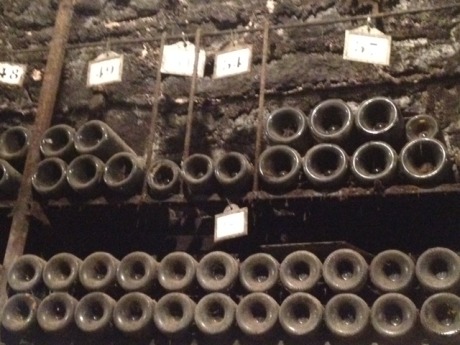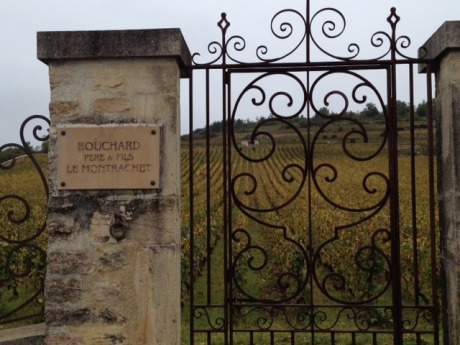Travels in Burgundy: Classifications and More Producer Visits
In the excitement of detailing my experiences at Drouhin and Patriarche in my previous post, I forgot that I’d wanted to provide a brief explanation of the wine classification system in Burgundy, which might provide some helpful context on my visits to producers in the region.
Super Wine Geek (SWG) Lexicon: Wine Classifications in Burgundy
Wines produced in Burgundy are classified into 4 groups (in ascending order of quality):
- Regional wines (around 50% of the area’s production) can be made from grapes grown anywhere in Burgundy, and are usually labeled either “Bourgogne Rouge” for reds and “Bourgogne Blanc” for whites. The grape variety is sometimes included on the back label, but typical of the region, it will most likely be either Pinot Noir (red) or Chardonnay (white). However, a few other grape types – most notably Aligoté for whites and Gamay for reds – might also be used.
- Village wines (around 40% of production) are made from grapes grown in proximity to a village, such as Pommard, Beaune, Meursault or Fixin.
- Premier Cru wines (around 9% of production, and sometimes identified on labels as “1er Cru”) are made from grapes grown in a specific area of a vineyard (called a “climat”) which has been designated as a Premier Cru plot.
- Grand Cru wines (1% of production) are made from a climat which has been designated as Grand Cru, which are considered to be the optimal terroir for growing Pinot Noir and Chardonnay grapes in Burgundy. Only 32 climats are designated Grand Cru in all of Burgundy.
The identification of which climats would be designated Premier Cru or Grand Cru were established over many centuries of observation by the monks who started producing wine in Burgundy in the 12th century, and these designations were formalized when France established wine laws on a national level in 1936.
For additional detail on the classification and regions within Burgundy (with maps!), check out this excellent post over at Wine Folly.
And now… on to visits to Bouchard and Château de Meursault!
Tasting and Tour at Bouchard Père & Fils
Bouchard Père & Fils is one of the largest domaines in Burgundy, with an annual production of 3.5 million bottles. Like Drouhin and Patriarche, Bouchard produces estate wines from grapes that they grow (25% of production) and also serves as a negociant to purchase grapes grown by others to produce wine (75% of production). Founded in 1731, Bouchard is housed on the edge of the old walled city of Beaune in the Château de Beaune. The Château is a former royal fortress built by King Louis XI and purchased after the French Revolution by Bernard Bouchard, the son of the founder. Today, the Château property is split in two by a street, the Rue de Château. During the cellar tour, we entered the Château on one side of the street and then emerged from the cellars into a beautiful walled garden on the other side of the street!
Bouchard is no longer family-owned; it was purchased in 1995 by Champagne house Joseph Henriot. Since the acquisition, Henriot has been upgrading Bouchard’s winemaking facilities and purchasing additional vineyards to expand their vineyard holdings (especially of plots within Grand Cru vineyards) and their production of estate wines. Bouchard does maintain a strong sense of its long history; holdings in the cellar at the Château include over 2,000 bottles of past vintages, including some from the 19th century!

It’s hard to tell from the picture, but each of the hanging white tags has two digits, which means that these are wines from the 19th century.
I tasted 7 wines at Bouchard. In traditional Burgundian fashion, the tasting order was reversed, so we tasted the red wines before the whites. (Most producers in the region now adhere to the typical white-before-red convention, so Bouchard was only one of two producers I visited who flipped the script.) The reds were a 2009 Beaune, a 2010 Pommard, and a 2009 Beaune du Château Premier Cru (a blend of grapes from 17 different plots of Premier Cru vineyards around Beaune). The whites were a 2011 Pouilly Fuisse, a 2010 Beaune du Château, a 2011 Meursault, and a 2011 Puligny-Montrachet. My favorite was the third red, the 2009 Beaune du Château Premier Cru – a bottle of which accompanied me back to Texas!
Tasting and Tour at Château de Meursault
My experience at Château de Meursault was yet another creepy self-guided cellar tour, with the tasting at the end conducted by a lovely gentleman who had been with the Château for nearly 10 years. This was the only other producer who had the tasting arranged as red-before-white.
I tasted 7 wines here also – 3 reds (2010 Savigny-Lès-Beaune, 2011 Beaune Premier Cru, 2009 Volnay Premier Cru) and 4 whites (2011 Bourgogne Clos du Château, 2011 Meursault du Château, 2009 Château de Meursault Premier Cru Les Charmes, and 2009 Château de Meursault Premier Cru Les Perrières). Once again, I acquired a bottle of my favorite of the tasting, the 2009 Château de Meursault Premier Cru Les Charmes, which was made from grapes grown in a single Premier Cru vineyard (named Les Charmes).
Until next time, cheers!

